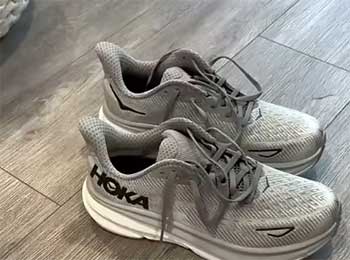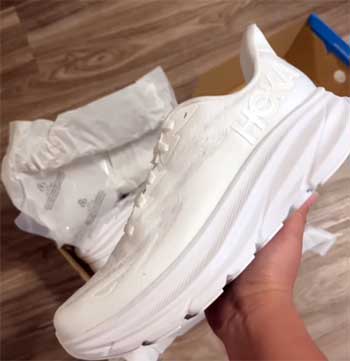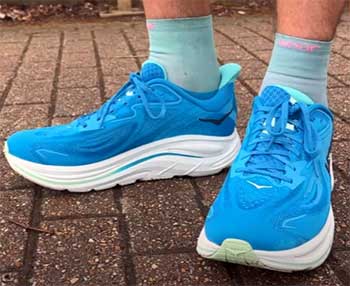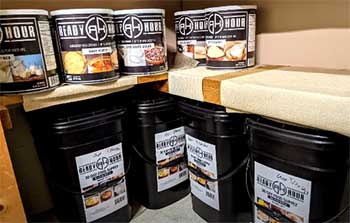I’ve been lacing up running shoes for years, pounding pavement and trails alike, and I’ve learned one thing: the right shoe can make or break your run. Today, I’m putting two heavyweights in the neutral running shoe arena head-to-head: the HOKA Clifton and the Brooks Ghost.
My goal?
To help you decide which shoe fits your running style, whether you’re chasing miles or strolling through your neighborhood. I’ll break down their features, weigh their pros and cons, and share my experience to guide your choice.
A Brief Comparison Table
| Feature | HOKA Clifton (9/10) | Brooks Ghost (15/16/17) |
| Weight | 7.3–9.0 oz (light) | 8.8–10.1 oz (slightly heavier) |
| Heel-to-Toe Drop | 5mm (low, midfoot strike) | 10–12mm (higher, heel strike) |
| Cushioning | CMEVA foam, plush, responsive | DNA Loft v3, soft, heel-focused |
| Stability | J-Frame, meta-rocker, midfoot support | GuideRails, heel-focused stability |
| Toe Box | Narrow, wide option available | Roomier, better for wider feet |
| Durability | 400–600 miles, outsole wear | 300–500 miles, durable upper |
| Breathability | Engineered mesh, highly breathable | Breathable upper, slightly less airy |
| Price | ~$145 | ~$140–$160 |
| Best For | Long runs, daily training, lightweight | Daily training, walking, heel strikers |
My Journey With The HOKA Clifton

When I first slipped into the HOKA Clifton 9, it felt like stepping onto a cloud with a spring in its step.
The lightweight design—clocking in at just 7.3 ounces for women’s sizes and 9.0 for men’s—made my feet feel unburdened, almost like I was running barefoot but with a plush safety net.
The signature CMEVA (compression-molded EVA) foam delivers a soft yet responsive ride, perfect for long, steady runs where you want comfort without feeling bogged down.
The Clifton’s meta-rocker design, a curved sole that mimics a rocking chair, propels you forward with each step.
As a heel striker with occasional plantar fasciitis, I found this early-stage rocker (starting midfoot) eased the strain on my heels, encouraging a smoother transition to my forefoot.
It’s like the shoe does half the work for you, rolling your foot naturally through each stride. The 5mm heel-to-toe drop keeps things low, promoting a midfoot strike, which felt natural for my gait but might take adjusting if you’re used to higher drops.
The upper, made of engineered mesh, is a breathability champ. During sweaty summer runs, my feet stayed cool, with air flowing freely through the knit. However, the toe box is snug—almost too snug for my wider forefoot.
HOKA offers a wide version, which I switched to for better comfort, but it’s something to consider if your feet need room to splay. The J-Frame technology, a supportive foam layer cupping the heel, adds stability without feeling rigid, making the Clifton a solid pick for neutral runners who want a touch of guidance.
On the durability front, I’ve logged over 500 miles in my Cliftons, including a grueling 600-mile walk across Spain’s Camino de Santiago, as one reviewer shared.
The durabrasion rubber outsole held up impressively on varied surfaces—cobblestone, gravel, and pavement—though the heel and outer corners showed wear by the end. The foam, while plush, started to lose its bounce after 400 miles, a common trait with HOKA’s lighter materials.
Pros of HOKA Clifton

- Featherlight Build for Effortless Runs: At 7.3–9.0 ounces, the Clifton feels like an extension of your foot, making every stride feel light and free. On a 12-mile trail run through rolling hills, the minimal weight kept my legs fresh, unlike heavier shoes that drag me down by mile 10. It’s a dream for runners who prioritize agility over long distances or during tempo sessions where every ounce counts.
- Plush Yet Responsive Cushioning: The CMEVA foam delivers a perfect blend of softness and springiness, with a 40mm heel stack that absorbs impact while returning energy. During a half-marathon, it cushioned my landings on hard pavement while giving a lively push-off, reducing fatigue and keeping my stride smooth even as the miles piled up.
- Meta-Rocker for Seamless Strides: The curved sole design mimics a rocking chair, guiding your foot through a natural, rolling motion. It eased my plantar fasciitis by reducing heel stress, and on a 15-mile run with mixed terrain, it felt like the shoe was propelling me forward, cutting strain on my knees and ankles for a fluid gait.
- Exceptional Breathability Keeps Feet Cool: The engineered mesh upper is a ventilation powerhouse. On a 90°F, 10-mile run in humid conditions, my feet stayed dry and cool, with no hot spots or sweaty buildup. The airy design made summer runs feel like a breeze, even when the weather was anything but.
- Subtle Stability for Confident Strides: The J-Frame, a firmer foam layer cupping the heel, and the wide base provide just enough support for neutral runners or mild overpronators. On uneven city sidewalks and gravel paths, I felt secure, with no wobbling or rolling, making it ideal for runners who want guidance without heavy correction.
- Versatile Across Distances and Terrains: The Clifton shines in daily training, long runs, and even light trail adventures. I wore it for a 20-mile training run across pavement and gravel, and its lightweight build and rocker made every mile feel manageable, adapting to varied paces and surfaces with ease.
- Vibrant Color Options for Style: With 21 colorways, the Clifton lets you run in style. I picked a bright coral pair that sparked compliments at my running club, adding a fun, personal touch to my gear that boosted my motivation on dreary morning runs.
- Wide Fit Availability Saves Wider Feet: The wide version was a game-changer for my broader forefoot, offering room to splay without sacrificing the snug midfoot fit. It eliminated the pinching I felt in the standard version, ensuring comfort on long runs without constant readjustment.
- Supportive for Injury-Prone Runners: The meta-rocker and plush foam make the Clifton a go-to for runners with joint issues. My plantar fasciitis flare-ups were less frequent, and the shoe’s design reduced stress on my Achilles during a 10-mile hilly route, making it a reliable choice for injury management.
- Smooth Transition for All Paces: Whether jogging at an 8-minute mile or pushing a 6-minute pace, the Clifton’s rocker design and responsive foam keep transitions smooth. I noticed this during a fartlek session, where the shoe adapted to speed changes without feeling clunky or unresponsive.
Cons of HOKA Clifton

- Snug Toe Box in Standard Fit: The standard Clifton’s toe box felt constricting for my wider forefoot, causing discomfort after 5 miles until I switched to the wide version. Runners with broad feet should try on or opt for the wide fit to avoid pinching or blisters, which was a hassle for me initially.
- Durability Wanes with High Mileage: The durabrasion rubber outsole lasts 400–600 miles, but the heel and outer edges wore down faster on abrasive asphalt. By 450 miles, the foam compressed, dulling its responsiveness, which was noticeable on long runs where I missed the initial bounce.
- Not Built for Speedwork: The Clifton excels for endurance but lacks the snap for sprints or tempo runs. In a 5K race, it felt sluggish compared to racier shoes like HOKA’s Mach, holding me back when I tried to push for a personal best.
- Adjustment Period for Low Drop: The 5mm drop promotes a midfoot strike, which felt unnatural for my heel-striking gait at first. It took a week of short runs to adjust, and runners used to higher drops might find this transition frustrating or strain their calves initially.
- Pricey for Budget-Conscious Runners: At ~$145, the Clifton’s advanced tech comes at a premium. While worth it for dedicated runners, casual joggers or those on a tight budget might hesitate, especially when cheaper alternatives offer similar cushioning.
- Slippery on Wet Surfaces: The outsole grips well on dry pavement but falters on wet trails or slick roads. During a rainy 8-mile run, I slowed down to avoid skidding, which disrupted my pace and confidence on wet surfaces.
- Foam Compression Reduces Longevity: After 400 miles, the CMEVA foam started to feel flat, diminishing its lively feel. For high-mileage runners like me, this means replacing the shoe sooner, adding to long-term costs and frustration.
- Less Aggressive Traction for Off-Road: The outsole struggles on loose gravel or muddy paths compared to trail-specific shoes. During a light trail run, I felt less grip on uneven terrain, limiting the Clifton’s versatility for mixed-surface runners.
- Narrow Fit May Not Suit Swollen Feet: On ultra-long runs (15+ miles), my feet swelled slightly, and the standard fit felt restrictive. Even the wide version was snugger than ideal, which could bother runners prone to swelling during marathons.
- Limited Arch Support for High Arches: The Clifton’s neutral design offers moderate arch support, but for my high arches, it felt slightly lacking during 10+ mile runs, requiring me to pair it with custom insoles for extra comfort.
The Brooks Ghost: A Reliable Workhorse

Switching to the Brooks Ghost (I tested the 15 and 16, with notes on the 17), I noticed a different vibe.
At 8.8–10.1 ounces, it’s heavier than the Clifton, but it feels sturdy, like a trusted friend who’s always there for you.
The DNA Loft v3 foam, nitrogen-infused for extra pop, offers a softer, heel-focused cushion that’s a dream for heel strikers like me.
The 12mm drop (35.5mm heel, 23.5mm forefoot) suits runners who land heavily on their heels, providing a cushioned landing that absorbs shock beautifully.
The Ghost’s upper is breathable but slightly less airy than the Clifton’s mesh.
Its roomier toe box was a godsend for my wider feet, letting my toes spread naturally without feeling cramped.
The segmented crash pad underfoot smooths transitions, though it lacks the Clifton’s rocker-like propulsion.
Instead, the Ghost feels grounded, with GuideRails technology offering subtle heel stability. It’s not as aggressive as HOKA’s J-Frame but keeps your foot centered, especially during long runs or walks.
Durability is a strong suit for the Ghost. I’ve pushed mine to 450 miles, and while the outsole shows wear, the upper and midsole hold up better than the Clifton’s. Brooks’ synthetic upper feels less flexible but more robust, resisting stretching over time.
The Ghost 16 is also carbon-neutral, a nod to sustainability with recycled materials, which is a nice touch for eco-conscious runners.
Pros of Brooks Ghost
- Luxurious Heel Cushioning for Comfort: The DNA Loft v3 foam delivers a pillowy landing, especially for heel strikers. On a 9-mile urban walk, the 35.5mm heel stack soaked up concrete impact, leaving my feet happy and fatigue-free.
- Spacious Toe Box for Natural Fit: The roomy forefoot lets toes spread freely, a godsend for my wider feet. After long runs, I had no blisters or pressure points, unlike tighter shoes that cramped my toes.
- Rock-Solid Durability: The synthetic upper and dense midsole last 300–500 miles with minimal wear. At 450 miles, my Ghost 15 still felt structured, outlasting the Clifton’s foam and outsole in longevity.
- Stable Ride with GuideRails: The heel-focused GuideRails keep your foot aligned, especially when fatigue sets in. During a 10-mile run, they prevented rolling, offering subtle support for my mild overpronation.
- Eco-Friendly Design: The Ghost 16’s carbon-neutral build, with recycled polyester and reduced emissions, aligns with my values as an eco-conscious runner. It’s a small but meaningful step toward sustainability.
- Versatile for Multiple Activities: From daily runs to gym workouts or standing at a desk job, the Ghost’s plush cushioning and stable platform make it a do-it-all shoe. I wore it for a 6-hour shift and felt no discomfort.
- True-to-Size Fit: The Ghost fits like a glove right out of the box, with no need for sizing up unless you prefer extra wiggle room. This consistency made it easy to order online confidently.
- Great for Long Walks: The soft heel cushioning and roomy fit make the Ghost a walker’s dream. I used it for a 15-mile charity walk, and my feet felt supported the entire way.
Cons of Brooks Ghost

- Heavier Than Competitors: At 8.8–10.1 ounces, the Ghost feels clunky compared to the Clifton, especially during faster runs. In a 5K, the extra weight slowed my cadence, making it less nimble.
- Higher Drop Limits Versatility: The 12mm drop suits heel strikers but feels awkward for midfoot or forefoot runners. I noticed a clunky transition during sprints, which threw off my rhythm.
- Less Breathable Upper: The synthetic upper, while durable, traps more heat than the Clifton’s mesh. On a hot 7-mile run, my feet felt warmer, leading to slight discomfort by the end.
- Lacks Propulsive Energy: The soft DNA Loft v3 foam prioritizes comfort over responsiveness, making the Ghost feel sluggish for speedwork. It couldn’t match the Clifton’s lively push-off during tempo runs.
- Limited Color Variety: With only 9 colorways compared to the Clifton’s 21, the Ghost feels less exciting for runners who love bold or unique designs. My gray pair felt a bit plain.
- Stiffer Upper Material: The synthetic upper, while durable, is less flexible than the Clifton’s mesh, feeling slightly restrictive during long runs or when my feet swelled slightly.
- Moderate Traction on Wet Surfaces: Like the Clifton, the Ghost’s outsole slips on wet pavement or slick trails. During a rainy jog, I had to tread carefully to avoid losing grip.
- Heel-Focused Stability Limits Midfoot Support: The GuideRails excel for heel strikers but offer less midfoot guidance. For runners needing all-around stability, the Clifton’s J-Frame feels more balanced
Also Read: Comparison of Hoka Mach 6 And Clifton 9 Shoes.
Fit And Feel: How They Stack Up?
Trying on both shoes felt like choosing between two great but different friends. The Clifton’s snug fit hugged my midfoot, but the narrow toe box initially squeezed my forefoot until I grabbed the wide version.
The Ghost, on the other hand, welcomed my feet with open arms—its roomier toe box and slightly looser fit felt like slipping into cozy slippers. If you have narrow feet, the Clifton might feel perfect; wider feet will thank the Ghost.
The Clifton’s low 5mm drop encourages a midfoot strike, which I adapted to after a few runs. It felt like the shoe was guiding my stride, almost like a gentle nudge forward. The Ghost’s 12mm drop, however, catered to my natural heel strike, offering a plush landing that absorbed impact on long runs.
The tradeoff? The Ghost felt less dynamic, more like a steady workhorse than a sprightly gazelle.
Cushioning And Comfort: The Heart of The Debate

Cushioning is where these shoes shine, but they deliver it differently.
The Clifton’s CMEVA foam is light and responsive, with a 40mm heel stack that feels plush yet never mushy.
It’s like running on a firm mattress—supportive but with enough give to keep you comfortable.
I loved it for 10-mile runs, where my legs stayed fresh thanks to the meta-rocker’s smooth transitions.
The Ghost’s DNA Loft v3 foam, with a 35.5mm heel stack, leans into heel cushioning.
It’s softer, almost pillowy, making it a dream for long walks or recovery runs. During a 9-mile hike, the Ghost kept my feet happy, though it lacked the Clifton’s lively bounce.
For runners who prioritize softness over responsiveness, the Ghost is tough to beat.
Stability: Who Keeps You Grounded?
Stability is a key differentiator. The Clifton’s J-Frame and meta-rocker design provide midfoot support, cradling the foot to prevent rolling. I felt secure on uneven sidewalks, and the wide base added confidence on gravel paths.
It’s not a stability shoe per se, but it offers enough guidance for neutral runners or those with mild overpronation.
The Ghost’s GuideRails focus on heel stability, keeping your rearfoot aligned. This was noticeable during long runs when fatigue set in—my form stayed intact without feeling overly corrected. However, its softer midsole makes it slightly less stable than the Clifton’s firmer setup.
If you need robust stability, the Ghost edges out slightly for heel strikers, but the Clifton feels more versatile overall.
Performance: From Daily Runs To Long Hauls
I tested both shoes across various runs—short 5Ks, tempo sessions, and 15-mile long runs. The Clifton excelled in daily training, its lightweight build and rocker design making miles feel effortless. However, during speedwork, it lacked the snap I craved; it’s not built for sprints.
The Ghost, while versatile, felt sluggish at higher paces due to its weight and softer foam. It shone on easy runs and walks, where its plush cushioning kept my feet happy.
For long distances, the Clifton’s responsiveness and lower drop gave it an edge for me, especially on trails or mixed surfaces.
The Ghost, however, was my go-to for urban runs, where its heel cushioning soaked up the impact of concrete. Both are stellar daily trainers, but the Clifton feels livelier, while the Ghost prioritizes comfort.
Durability and Value: Which Lasts Longer?

After logging serious miles, I noticed differences in wear.
The Clifton’s outsole, made of durabrasion rubber, held up well but showed heel wear after 500 miles. The foam compressed slightly, reducing its springiness.
The Ghost’s denser midsole and synthetic upper felt more resilient, with less compression even at 450 miles. Its outsole wore evenly, though not as grippy on wet surfaces as the Clifton.
Price-wise, the Clifton (~$145) and Ghost (~$140–$160) are close, but the Ghost’s durability gives it a slight edge for value.
If you’re a high-mileage runner, the Ghost might save you a few bucks long-term. For lighter runners or those prioritizing cushioning, the Clifton’s premium feel justifies its cost.
Who Are These Shoes For?
The Clifton is your match if you love a lightweight, responsive ride with a natural stride. It’s perfect for long runs, daily training, or even walking if you don’t mind a snugger fit. Runners with plantar fasciitis or heel strikers benefit from its rocker design, but speed demons might want a peppier shoe like HOKA’s Mach.
The Ghost suits heel strikers and walkers who crave plush cushioning and a roomy fit. It’s a workhorse for daily runs, gym sessions, or standing all day. If you have wider feet or need extra heel support, the Ghost feels like home. It’s less ideal for forefoot strikers or those chasing PRs.
Also Read: Comparison of Hoka Transport And Clifton 9 Shoes.
Frequently Asked Questions (FAQ)
HOKAs, like the Clifton, run snug, especially in the toe box, but offer a wide option. Brooks, like the Ghost, have a roomier toe box and fit true to size, though some recommend sizing up half a step.
Brooks Ghost is better for walking due to its plush heel cushioning and roomy fit, ideal for long hours on your feet. HOKA Clifton works well but feels less cushioned for extended walking.
HOKA Clifton’s meta-rocker and plush CMEVA foam reduce joint impact, making it slightly better for knee pain. Brooks Ghost’s soft heel cushioning also helps but is less effective for midfoot strikers.
The HOKA Clifton excels for long runs, daily training, and runners with plantar fasciitis, thanks to its lightweight design, responsive cushioning, and meta-rocker for smooth strides.
Conclusion: Your Run, Your Choice
You’ve got two fantastic shoes here, each with its own personality. The HOKA Clifton is your lively, lightweight partner, perfect for gliding through long runs with a springy, natural feel. The Brooks Ghost is your steady, cushioned companion, ready to soak up miles or keep you comfy on long walks.
Think about your running style, foot shape, and goals. Try them on if you can—you’ll feel the difference. Whichever you choose, you’re stepping into a shoe that’s earned its stripes among runners like us.

